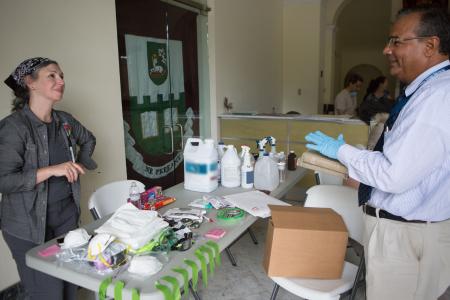Despite my long experience responding to many an incident affecting cultural heritage infrastructure and collections, since 2016, I have gained valuable experience living through the Atlantic hurricane season from the perspectives of both a professional immersed in the disaster lifecycle (preparedness, response, recovery, and mitigation), and the individuals, businesses, and communities directly affected and overwhelmed by such a circumstance.
I recently returned from Puerto Rico with colleagues from multiple federal agencies as part of the Heritage Emergency National Task Force (FEMA-HENTF), co-sponsored by the Smithsonian and the Federal Emergency Management Agency (FEMA). We operate under Emergency Support Function 11, protecting Natural, Cultural Resources, and Historical Properties (NCH) “to preserve, conserve, rehabilitate, and inform long-term recovery of NCH resources…. providing post event assessments of damages and providing technical assistance and resources for assessing impacts of response activities on NCH resources.”

Between assisting individuals in FEMA Disaster Recovery Centers in Louisiana after Hurricane Matthew, and most recently in San Juan serving cultural organizations all over the Territory of Puerto Rico operating out of the FEMA Joint Field Office, I have both taught and learned much in less than idyllic, but very realistic conditions. We who are trained to respond to cultural heritage disasters may be well-versed in “Ivory Tower” theory and practice of response, but may not always understand the gravity, immensity, and sheer overwhelmingness of these situations.
When working in a disaster zone as an outsider, it is important to be able to self-manage and yet work in a quickly-assembled team of staff you may or may not know well, while working within established protocols of the National Incident Management System (NIMS) and Incident Command System (ICS). Beyond topical expertise as a Subject Matter Expert, the team member is expected to be flexible, and to be able to gauge an appropriate response scaled to the situation at hand with sensitivity and empathy.
In training heritage responders, we speak of resiliency and preparedness, and now it is time to pass on some of those lessons learned to colleagues in federal agencies, so that they are prepared to answer the call when FEMA-HENTF taps them on the shoulder, and resilient for the sometimes challenging, but ultimately rewarding, work ahead.
Please join us, the members of the Puerto Rico travel team including staff from Smithsonian, National Archives and Records Adminstration, and the National Park Service, on January 3, 2018 to hear some tips and truths at the talk and question and answer session, entitled “And don’t forget your badge this time! Lessons from the field with FEMA Heritage Emergency National Task Force” at the upcoming Washington Conservation Guild’s 3-Ring Circus, in the Collections Emergency Response Ring. This event is open to the public, however a contribution is requested.
Related Resources
Produced by the Smithsonian Institution Archives. For copyright questions, please see the Terms of Use.

Leave a Comment